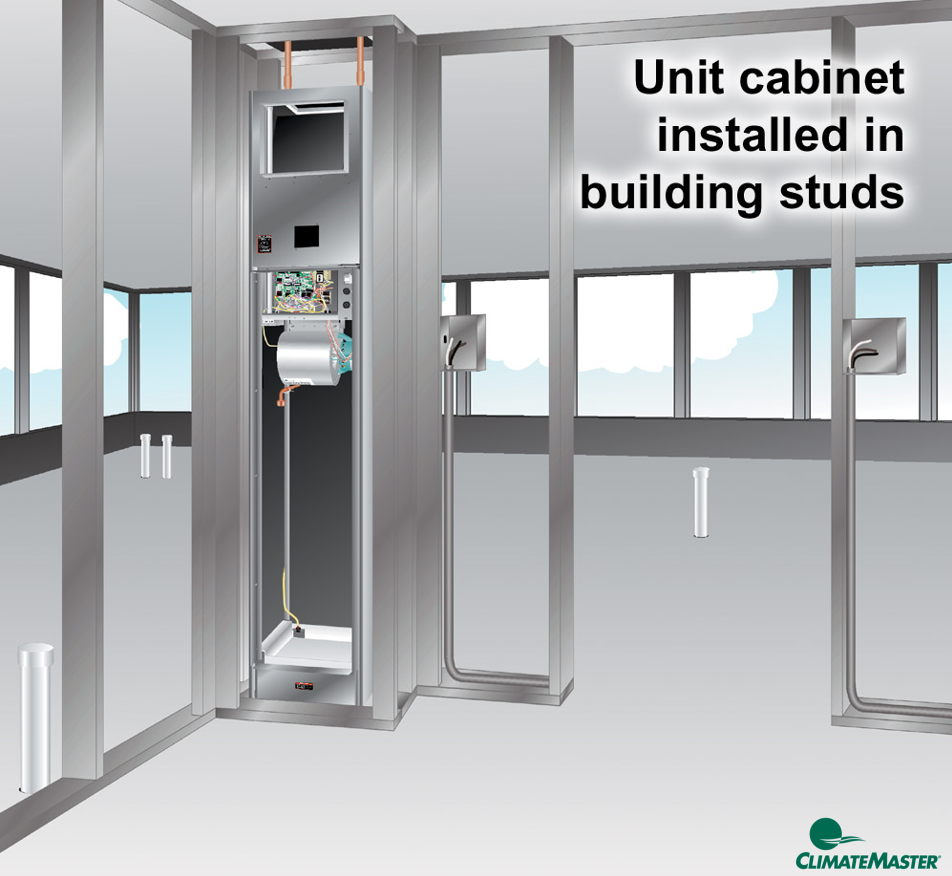Introduction to Water Source Heat Pump Systems Part 2: When and Where to Use Them
/By Chad Edmondson
Water source heat pump (WSHP) systems can be successfully and advantageously applied in a wide variety of commercial, institutional, and multi-unit residential buildings. The commonality that makes any of these potentially suitable for WSHP design is the need for simultaneous heating and cooling with individualized zone control. But WSHPs can be useful in meeting other requirements as well.
Helps Facilities Meet ASHRAE Standard 15 & 34 Refrigeration Limits
Individual WSHP units use only a small amount of refrigerant, all of which is completely contained within a single unit. In other words there are no shared refrigerant lines between units like there is, for example, in variable refrigerant (VRF) systems. So if a leak should occur it will amount to just several ounces of refrigerant versus many pounds. This is an advantage in itself, but it is also useful when it comes to meeting ASHRAE 15, which limits the amount of refrigerant that is considered safe in a closed environment.
Institutional facilities have stricter limitations on the amount of refrigerant that is considered safe for the occupants should a leak occur.
When Peace and Quiet Is a Priority
WSHPs are remarkably quiet thanks to new compressor technology and acoustical isolation techniques. In fact, they can be applied to a single zone without introducing any more noise than a fan coil. On the other hand, the chillers and high-speed, high static centrifugal fans used in centralized HVAC systems generate a lot of noise that can be transmitted to occupied spaces. This makes WSHPs a desirable alternative to centralized equipment in many learning or working environments.
Facilitates Metering in Tenant Situations
Tenant properties benefit from the individual control and metering capabilities of WSHP systems. Tenants have control over their own indoor environment while landlords or property owners can charge tenants for their respective energy use. Governmental buildings and military installations also frequently require individualized control and metering.
Simplifies Piping in Multi-Story, Multi-Unit Applications
In multi-story buildings, particularly hotels and multifamily residences, WSHPs can be installed in a stacked fashion within a vertical chase. The units are simply, “furred in” within the riser column. These tall, thin units are not only small in footprint, they are also very easy to pipe since the piping is pre-measured, and pre-fabricated at the factory. A removeable unit chassis provides ideal accessibility for servicing.
The supply and return piping can be configured in a myriad of ways to accommodate the space layout and zone requirements. Plus, vertical stack installations can significantly reduce the amount of required piping. This application works especially well in buildings with identical zones on each floor. The cabinet doors blend right into the wall surface of the space or the units may be tucked into a small closet.
Meets a Wide Variety of Renovation & Retrofit Situations
Since WSHP systems are highly adaptable, they can be an excellent choice in building retrofits and renovations. Case-in-point is the new ASHRAE Global Headquarters in Peachtree Corners, GA. The 66,700 sq ft building, originally built in 1978, was redesigned by ASHRAE for net-zero energy consumption. It incorporates a host of sustainable building strategies including photovoltaic (PV) panels, radiant ceiling panels, daylighting and more.
Six WSHPs were chosen for conditioning the basement and an upper level atrium. The units are supplied with air from dedicated outdoor air systems located on the rooftop and chilled water from the return chilled water from the radiant ceiling panels since WSHPs utilize a higher supply water temperature than typical air conditioning equipment. The WSHPs in the basement were chosen to save energy in a space that is primarily used for storage while the ones serving the Atrium were chosen due to the lack of ceiling in that space.
ASHRAE has also applied energy meters to the heat pumps and other equipment used throughout the building.
Next up we will look at how a WSHP operates and why extracting or rejecting BTUs from water is inherently more efficient then trying to do so into air.




